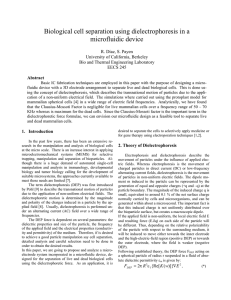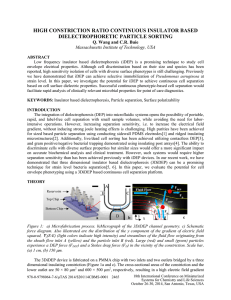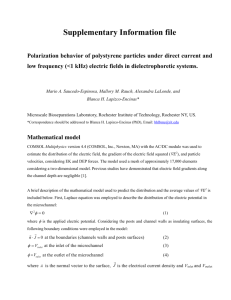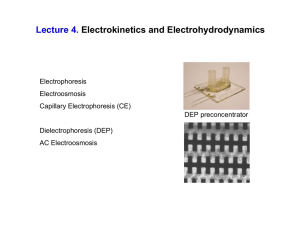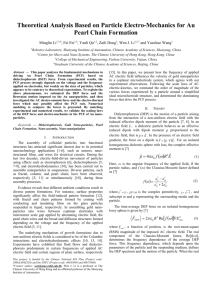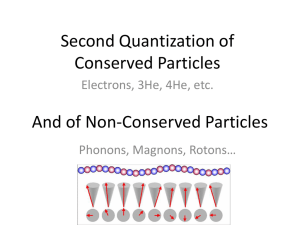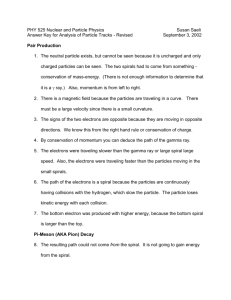Mathematical model
advertisement
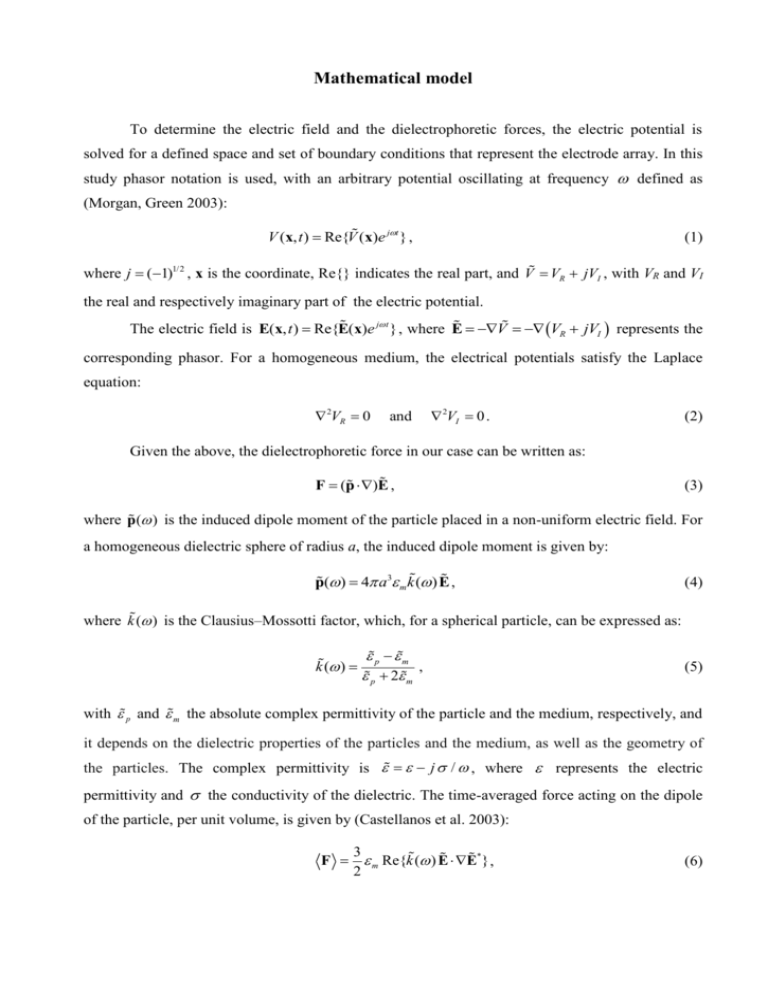
Mathematical model
To determine the electric field and the dielectrophoretic forces, the electric potential is
solved for a defined space and set of boundary conditions that represent the electrode array. In this
study phasor notation is used, with an arbitrary potential oscillating at frequency defined as
(Morgan, Green 2003):
V (x, t ) Re{V (x)e jt } ,
(1)
where j (1)1/2 , x is the coordinate, Re{} indicates the real part, and V VR jVI , with VR and VI
the real and respectively imaginary part of the electric potential.
The electric field is E(x, t ) Re{E(x)e j t } , where E V VR jVI represents the
corresponding phasor. For a homogeneous medium, the electrical potentials satisfy the Laplace
equation:
2VR 0
and
2VI 0 .
(2)
Given the above, the dielectrophoretic force in our case can be written as:
F (p )E ,
(3)
where p( ) is the induced dipole moment of the particle placed in a non-uniform electric field. For
a homogeneous dielectric sphere of radius a, the induced dipole moment is given by:
p() 4 a3 m k () E ,
(4)
where k ( ) is the Clausius–Mossotti factor, which, for a spherical particle, can be expressed as:
k ( )
p m
,
p 2 m
(5)
with p and m the absolute complex permittivity of the particle and the medium, respectively, and
it depends on the dielectric properties of the particles and the medium, as well as the geometry of
the particles. The complex permittivity is j / , where represents the electric
permittivity and the conductivity of the dielectric. The time-averaged force acting on the dipole
of the particle, per unit volume, is given by (Castellanos et al. 2003):
3
F m Re{k ( ) E E*} ,
2
(6)
where “ ” indicates the complex conjugate. After some mathematical manipulation, it can be
shown that the force in Eq. (6) comprises two independent contributions (the subscripts r and i
denote the real and imaginary parts):
3
3
F m kr | E |2 m ki ( Er Ei ) .
4
2
(7)
The first term relates to an electric field which is non-uniform in magnitude but does not
exhibit any phase variation. Equation (7) suggests that dielectrophoresis can be used as an effective
method for separating particles, solely according to their dielectric properties and sizes, an
important step forward in nanoparticle manipulation. In a dielectric medium, the direction of the
DEP force is influenced by the polarizability of the particle, which depends on the permittivity of
the particle and the suspending medium. This behavior is expressed by kr () ; when the sign of
kr () is positive, the particle is more polarizable than its surrounding medium and its movement is
oriented towards regions with the highest field strength. When kr () is negative, particles with
polarizability less than that of the medium move towards the region with the lowest field gradient.
These phenomena are known as positive dielectrophoresis (pDEP), respectively negative
dielectrophoresis (nDEP). As kr () has a complex dependence on the properties of the particle
(permittivity, conductivity) and the frequency of the applied field, a particle can experience both
positive and negative DEP forces based on the various possible combinations of the above
variables.
The second term of equation (7) is non-vanishing if the electric field has a spatially
dependent phase, and the dielectrophoresis resulting from such an electric field phase gradient is
known as “traveling wave dielectrophoresis” (twDEP). In traveling wave dielectrophoresis, the
positive DEP force pushes the particles along the direction of the traveling wave while the negative
DEP force pushes them in the opposite direction.
In the following, the two components of the force will be considered separately and referred
to as the DEP, respectively, the twDEP components of the force. Inserting the expressions for the
phasor, the time-averaged force components from equation (7) can be expressed as (Green et al.
2002; Lungu et al. 2010):
3
2
FDEP m kr VR VI
4
and, respectively:
2
2
,
(8)
3
FtwDEP m ki VR VI .
2
(9)
The real part of the Clausius-Mossotti factor gives the DEP force in the direction
perpendicular to the electrode array, while the imaginary part gives the twDEP force in the parallel
direction.
In order to avoid extreme numbers in the numerical calculations, the potential is scaled with
V0, the amplitude of the applied signal, and the distances are scaled with d, the distance between the
center of the electrode and the center of the adjacent gap.
In terms of dimensionless electric potentials V'R=VR/V0, V'I=VI/V0 and displacement x'=x/d,
the time-averaged expressions for the force components become:
FDEP F0 DEP VR VI
2
2
,
FtwDEP F0twDEP VR VI ,
(10)
(11)
V2
V2
3
3
where F0 DEP m kr 03 and F0twDEP m ki 03 , respectively.
2
d
4
d
The macroscopic behavior of a suspension of spherical particles in a dense and viscous fluid
can be modeled considering the mechanical equilibrium between an external spatially dependent
force F and the Stokes drag. When the size of the particles, relative to the length L of the
microchannel and the volume fraction of particles is small, the dynamics of the two-phase
system can be expressed by the following system of equations (Holmes et al. 2003, Neculae et al,
2012):
v u
2a 2
F , where u 0 ,
9
j 0 , where j v D .
t
(12a)
(12b)
Here u and v are the fluid and particle velocities, respectively, a the particle radius, η the viscosity
of the fluid, t the time, j the particle flux, D the diffusion coefficient of the particles and F denotes
the dielectrophoretic external field.
Using the scales of d , d 2 / D, D / d and 0 (the initial average volume fraction) for the
length, time, velocity and particle volume fraction, respectively, the problem is expressed in terms
of dimensionless variables by the following system of equations:
3
v u QF , where u 0 ,
j 0 , where j v D .
t
(13a)
(13b)
The prime symbol above denotes the dimensionless quantities, Q 2a 2 F0 d / 9 D with F0 a
measure of the intensity of the external field which will be detailed in the next section.
In a typical set-up, the DEP chamber has electrodes placed on both the bottom and top
surfaces as illustrated in Fig. 1. Let us consider a rectangular domain of sides ( Lx , Ly 2d , Lz )
where a harmonic electric potential V V0 exp(it qx) is imposed at the boundaries y d .
Fig. 1 Typical DEP device: micro-channel with interdigitated top and bottom electrodes.
V0 is the amplitude of the electric potential and q
2
is the wave number, where is the
wavelength of the traveling wave. By solving the Laplace equation V 0 , assuming that
Ly Lx , Lz , and the uncharged sidewalls, one can obtain the analytical solution of the problem
(Shklyaev, Straube 2008):
V (r ) V0 exp(iqx) cosh qy / cosh qd ,
(14)
and the final expression of the dielectrophoretic force becomes:
F r F0 F ,
(15)
where F0 3 mV02 q 3k R / 2 cosh 2 (b / 2) is a parameter related to the intensity of the force field,
corresponding to term F0 mentioned above, F k cosh by,sinh by,0 corresponds to the term F
in equation (13a), k is the ratio of the imaginary, ki , and real, kr , parts of the Clausius-Mossotti
factor given by equation (5), and b 2qd is the so called dimensionless wave number. The first
component of term F represents the dimensionless twDEP force, while the second component is
the dimensionless DEP force.
4
References
Castellanos A, Ramos A, Gonzales G, Green NG, Morgan H (2003) Electrohydrodynamics and
dielectrophoresis in microsystems: scaling laws. J. Phys. D: Appl. Phys. 36: 2584-2597, PII:
S0022-3727(03)63619-3
Green NG, Ramos A, Morgan H (2002) Numerical solution of the dielectrophoretic and travelling
wave forces for interdigitated electrode arrays using the finite element method. J. of Electrostatics
56: 235-254
Holmes D, Green NG, Morgan H (2003) Microdevices for Dielectrophoretic Flow-Through Cell
Separation. IEEE Engineering in Medicine and Biology Magazine 22: 85-90, doi:
10.1109/MEMB.2003.1266051
Lungu M, Neculae A, Bunoiu M (2010) Some considerations on the dielectrophoretic manipulation
of nanoparticles in fluid media. J. of Optoelectronics and Advanced Materials 12: 2423-2426
Morgan H, Green NG (2003) AC Electrokinetics: Colloids and nanoparticles, In: Research Studies
ltd. Baldock, Hertfordshire, 50–62, 200–210
Neculae A, Biris CG, Bunoiu M, Lungu M (2012) Numerical analysis of nanoparticle behavior in a
microfluidic channel under dielectrophoresis; J. Nanopart Res. 14: 1154-1165
Shklyaev S, Straube AV (2008) Particle entrapment in a fluid suspension as a
New Journal of Physics 10: 063030, doi:10.1088/1367-2630/10/6/063030
5
feedback effect.
